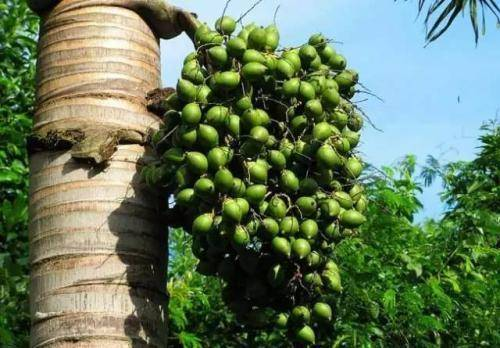Areca catechu
Overview
Areca catechu is an evergreen tree belonging to the genus Areca in the palm family. It is extensively grown in tropical regions and finds diverse applications in agriculture and industry. Areca catechu has been classified as a Class 1 carcinogen by the International Agency for Research on Cancer (IARC) under the World Health Organization. Consequently, it is prohibited in numerous European and American countries. Regular chewing of Areca catechu fruit is addictive and poses substantial risks, including severe dental damage and a heightened susceptibility to cancer.

Geographical Distribution
Areca catechu is native to Malaysia and is widely cultivated in tropical Asia. The areca catechu tree is mainly distributed in Southeast Asia, tropical Asia, East Africa and parts of Europe. In the Pacific region, it is mainly grown in Papua New Guinea, Solomon Islands, Fiji, Vanuatu and Micronesia. There are sporadic occurrences of areca catechu in Pinappé Island, the U.S. Mariana Islands, and the Marshall Islands. In the Hawaiian Islands, areca catechu is solely cultivated for ornamental purposes.
In China, areca catechu is mainly distributed in tropical areas such as Yunnan, Hainan and Taiwan.
Application
- Economic Uses: In Hainan, areca catechu is the second-largest cash crop after the rubber tree. Similarly, in Taiwan, it is the second-largest cash crop after rice.
- Medicinal Uses: Areca catechu is an important Chinese herb and is ranked among the top 5 southern medicines. Its seeds, rind, and flowers are used for medicinal purposes. Areca catechu contains alkaloids, tannins, flavonoids, terpenoids, and other chemical components, which exhibit digestive, hypotensive, antidepressant, antioxidant, anti-inflammatory, antiparasitic, and antibacterial activities.
- Other Industrial Applications: The pulp derived from the shell of Areca catechu is suitable for the production of corrugated base paper and other packaging paper.
Genome sequencing
In 2021, the Coconut Institute of the Chinese Academy of Tropical Agricultural Sciences, in collaboration with BGI-Shenzhen, successfully completed the sequencing splicing and sequence analysis of the areca palm genome. The team utilized a combination of Illumina and PacBio data, along with Hi-C mapping technologies, to generate a high-quality, chromosome-scale reference genome assembly. The assembled genome had a total length of 2.51 Gb, with a scaffold N50 of 1.7 Mb. Subsequently, the scaffolds were further assembled into 16 pseudochromosomes, with an N50 of 172 Mb. Through gene annotation, the areca palm genome was predicted to contain 31,571 protein-coding genes.
Reference
1.曾莉娟,李涛,张雨良,等. 槟榔基因组DNA的高效提取方法[J]. 江西农业学报,2010,22(2):58-59,63. DOI:10.3969/j.issn.1001-8581.2010.02.019.
2.邓通,刘义,黄显南,等. 槟榔壳原料及制浆性能研究[J]. 中国造纸,2017,36(9):39-42. DOI:10.11980/j.issn.0254-508X.2017.09.008.
3.张春江,吕飞杰,陶海腾. 槟榔活性成分及其功能作用的研究进展[J]. 中国食物与营养,2008(6):50-53. DOI:10.3969/j.issn.1006-9577.2008.06.015.
4.易攀,汤嫣然,周芳,等. 槟榔的化学成分和药理活性研究进展[J]. 中草药,2019,50(10):2498-2504. DOI:10.7501/j.issn.0253-2670.2019.10.034.
5.Yang Y, Huang L, Xu C, et al. Chromosome-scale genome assembly of areca palm (Areca catechu). Mol Ecol Resour. 2021;21(7):2504-2519. [OpenLBID: OLB-PM-34133844]
| Data Statistics | |
|---|---|
| Taxonomy ID | 184783 |
| Projects | - |
| Samples | - |
| Genomes | 1 |
| Variations | - |
| Expressions | - |
| Reference | areca_palm_Reyan |
| Refgenes | 31,569 |
| Cultivars | 42 |